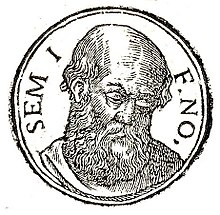
Back Sem (Bibel) ALS ሴም Amharic سام Arabic سام ARZ سام نوح اوغلو AZB Сим Bulgarian সাম Bengali/Bangla ཤེམ། Tibetan Shem Breton Sem (bíblic) Catalan
Shem | |
|---|---|
 Portrait from Promptuarium Iconum Insigniorum (1553) by Guillaume Rouillé | |
| Children | Elam Ashur Arphaxad Lud Aram |
| Father | Noah |
| Family | Japheth and Ham (brothers) |

Shem (/ʃɛm/; Hebrew: שֵׁם Šēm; Arabic: سَام, romanized: Sām)[a] is one of the sons of Noah in the Bible (Genesis 5–11[1] and 1 Chronicles 1:4).
The children of Shem are Elam, Ashur, Arphaxad, Lud and Aram, in addition to unnamed daughters. Abraham, the patriarch of Jews, Christians, and Muslims, is one of the descendants of Arphaxad.
In medieval and early modern European tradition he was considered to be the ancestor of the peoples of Asia,[2][3][4] and he gives his name to the title "Semites" formerly given to West Asian peoples.[5]
Islamic literature describes Shem as one of the believing sons of Noah. Some sources even identify Shem as a prophet in his own right and that he was the next prophet after his father.[6]

Cite error: There are <ref group=lower-alpha> tags or {{efn}} templates on this page, but the references will not show without a {{reflist|group=lower-alpha}} template or {{notelist}} template (see the help page).
- ^ Genesis 5:32, 6:10; 7:13; 9:18, 23, 26–27; 10; 11:10
- ^ Reynolds, Susan (October 1983). "Medieval Origines Gentium and the Community of the Realm". History. 68 (224). Chichester, West Sussex: Wiley-Blackwell: 375–390. doi:10.1111/j.1468-229X.1983.tb02193.x. JSTOR 24417596.
- ^ Javakhishvili, Ivane (1950), Historical-Ethnological problems of Georgia, the Caucasus and the Near East. Tbilisi, pp. 130–135 (in Georgian).
- ^ Kidd, Colin (2004) [1999]. British Identities Before Nationalism: Ethnicity and Nationhood in the Atlantic World, 1600-1800. Cambridge: Cambridge University Press. pp. 28–31. ISBN 0-521-62403-7.
- ^ "Who Are the Semites?".
- ^ Scott B. Noegel and Brannon M. Wheeler (2002). "Shem". In the Historical Dictionary of Prophets in Islam and Judaism. p. 301